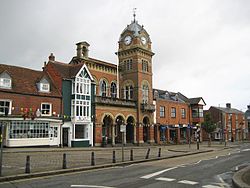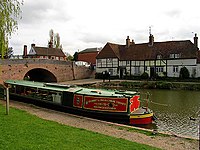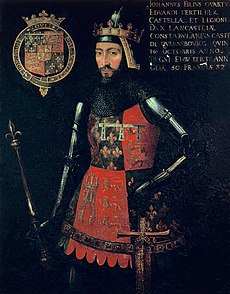Hungerford
| Hungerford | |
| Berkshire | |
|---|---|
 Hungerford Town Hall | |
| Location | |
| Grid reference: | SU337685 |
| Location: | 51°24’52"N, 1°30’53"W |
| Data | |
| Population: | 5,559 (2001) |
| Post town: | Hungerford |
| Postcode: | RG17 |
| Dialling code: | 01488 |
| Local Government | |
| Council: | West Berkshire |
| Parliamentary constituency: |
Newbury |
Hungerford is a modest market town in south-western Berkshire, nine miles west of Newbury. According to the 2001 census, the parish had a population of 5,559, estimated to have risen by 2006 to 6,789.
The lie of the land


Hungerford is on the River Dun in the Kennet Valley. It is the westernmost town in Berkshire, situated on the border with Wiltshire, and lies within the North Wessex Downs Area of Outstanding Natural Beauty. The highest point in Berkshire (and some would say the highest in South East England) is the 974-foot summit of Walbury Hill, four miles from the town. The Kennet and Avon Canal separates Hungerford from what might be described as the town's only suburb, the hamlet of Eddington.
Hungerford is close to the border of Berkshire with Wiltshire, which scuttles through the fields beyond the northern and western edges of the town. It is almost equidistant from the towns of Newbury in Berkshire and Marlborough in Wiltshire. It is 2½ miles south of Junction 14 of the M4 motorway.
The parish is divided into four tithings: Hungerford or Town, Sanden Fee, Eddington with Hidden and Newtown and Charnham Street. North and South Standen and Charnham Street are however regarded as detached parts of Wiltshire. Leverton and Calcot near the town belong to Wiltshire.
All the land south of the Kennet was formerly included in Savernake Forest.
Travel
Hungerford is situated on several transport routes, of both historic and current importance, including the M4 motorway (junction 14), the Old Bath Road (now transformed into the A4), and the Kennet and Avon Canal (opened 1811). It also has a railway station on the Reading to Taunton line; a reasonable rail service to Newbury, Reading and London means that the Hungerford has developed into something of a dormitory town which has been slowly expanding since the 1980s. Many residents commute to nearby towns such as Newbury, Swindon, Marlborough, Thatcham and Reading.
Social activities
Hocktide

Hungerford is the only place in the country to have continuously celebrated Hocktide or Tutti Day (the second Tuesday after Easter). Today it marks the end of the town council's financial and administrative year, but in the past it was a more general celebration associated with the town's great patron, John of Gaunt, 1st Duke of Lancaster. Its origins are said to lie in celebrations following King Alfred's expulsion of the Danes.
The 'Bellman' (or Town Crier) summons the Commoners of the town to the Hocktide Court held at the town hall, while two florally decorated 'Tutti Men' and the 'Orange Man' visit every house with commoners' rights (almost a hundred properties), accompanied by around six Tutti Girls, drawn from the local school. Originally they collected 'head pennies' to ensure fishing and grazing rights. Today, they largely collect kisses from each lady of the house. In the court, the town's officers are elected for the coming year and the accounts examined. The court manages the town hall, the John of Gaunt Inn, the Common, Freemen's Marsh, and fishing rites in the Rivers Kennet and Dun.
Hungerford Archers
The Hungerford Archers are a longbow archery club based in Hungerford. The club was founded by the late Bob Maslin in 1995 as the Hungerford Longbow Club (assuming its current name in 2005). It is a club only for the longbow and does not permit the general use of compound bows or crossbows. Member shoot at targets or practice, as in age-old days, "clout archery", where the target is a circle on the ground at long range (about 180 yards) so that the shooters must drop the arrows into using a high trajectory.
Legends
There is an old legend that "Hingwar the Dane" (which is to say Ivarr the Boneless) was drowned accidentally while crossing the Kennet here, and that the town was named after him. This stems from the tale that the Battle of Ethandun took place at Eddington in Berkshire rather than the more usually accepted Edington in Wiltshire or Edington in Somerset.
Literature
Hungerford may be Kennetbridge in Thomas Hardy's novel Jude the Obscure, but this is usually thought to be Newbury. Kennetbridge is "a thriving town not more than a dozen miles south of Marygreen"[1] (Fawley) and is between Melchester (Salisbury) and Christminster (Oxford).[2] The main road (A338) from Oxford to Salisbury runs past Fawley and through Hungerford, which is south of Fawley rather than south-east like Newbury.
History

Hungerford is an Old English name meaning 'Hanging Wood Ford'. The town's symbol is the six-pointed star and crescent moon.
The place does not occur in the Domesday Book of 1086, but certainly existed by 1173. By 1241, it called itself a borough. In the late 14th century, John of Gaunt, 1st Duke of Lancaster was lord of the manor and he granted the people the lucrative fishing rights on the River Kennet.
The noble family of Walter Hungerford, 1st Baron Hungerford originated from the town (c. 1450–1450), although after three generations the title passed to Mary, Baroness Hungerford who married Sir Edward (afterwards Lord) Hasting and the family seat moved to Heytesbury in Wiltshire.
During the English Civil War, the Earl of Essex and his army spent the night here in June 1644. In October of the same year, the Earl of Manchester's cavalry were also quartered in the town. Then, in the November, the King's forces arrived in Hungerford on their way to Abingdon.
During the Glorious Revolution of 1688, William of Orange was offered the Crown of England while staying at the Bear Inn in Hungerford.
St. Lawrence's parish church stands next to the Kennet and Avon Canal. It was rebuilt in 1814-1816 by John Pinch the elder in Gothic style and refurbished again in the 1850s.
In the late 19th century, two policeman were shot by poachers in Eddington. Their memorial crosses still stand where they fell.
On 19 August 1987 the town was the scene of the horrific Hungerford Massacre. A 27-year-old unemployed local labourer, Michael Robert Ryan, armed with several weapons including an AK-47 rifle and a Beretta pistol, shot and killed 16 people including his own mother, and wounded 15 others, then fatally shot himself. A report on this incident was commissioned by Home Secretary Douglas Hurd from the Chief Constable of Thames Valley Police, Colin Smith. It remains, along with the Dunblane massacre, one of the worst criminal atrocities involving firearms in British history. The massacre led to the Firearms (Amendment) Act 1988, which banned the ownership of semi-automatic centre-fire rifles and restricted the use of shotguns with a magazine capacity of more than two rounds. The Hungerford Report had demonstrated that Ryan's collection of weapons was legally licensed.
Outside links
- Hungerford Town Council
- Hungerford in West Berkshire
- Hungerford Historical Association
- Royal Berkshire History: Hungerford
References
- ↑ Paragraph 4, Chapter VII, Part Fifth, Thomas Hardy, Jude the Obscure at http://www.gutenberg.org/files/153/153-h/153-h.htm#5-7
- ↑ Paragraph 6, Chapter X, Part Third, Thomas Hardy, Jude the Obscure at http://www.gutenberg.org/files/153/153-h/153-h.htm#5-7